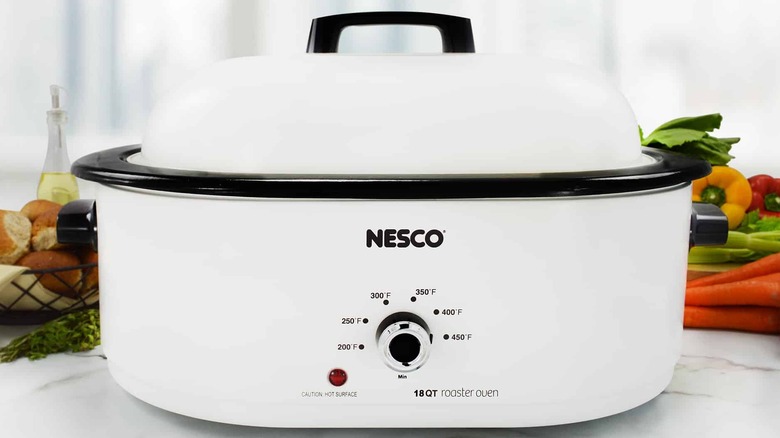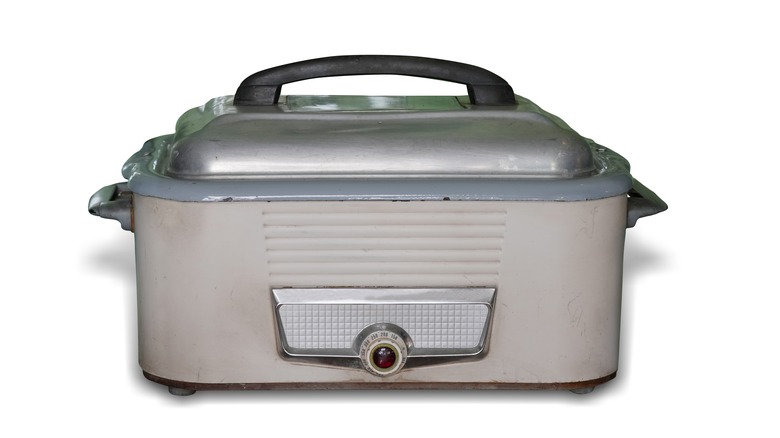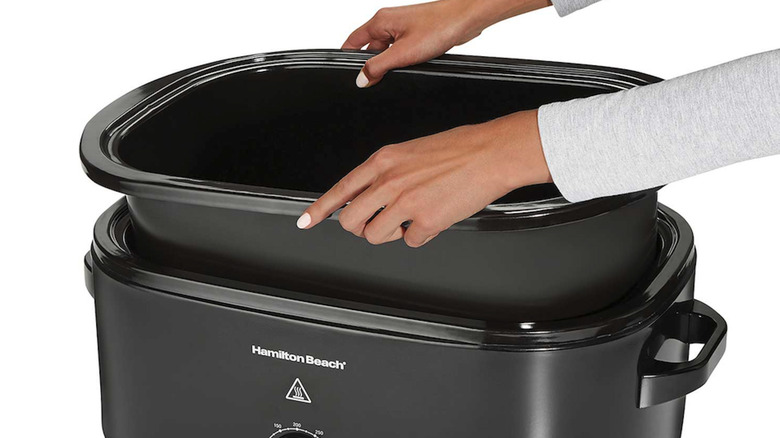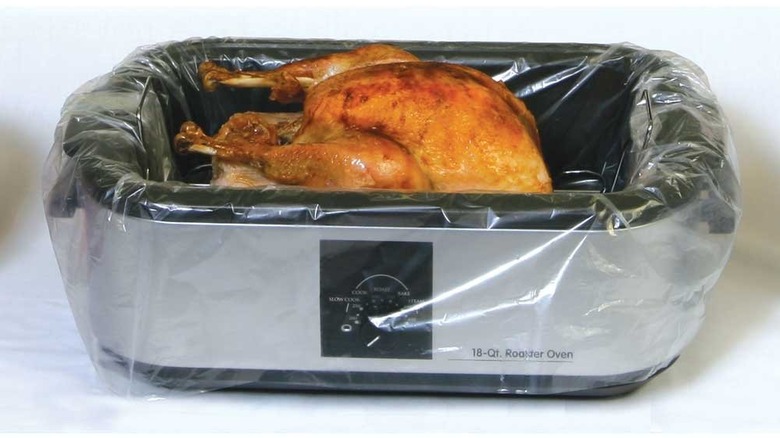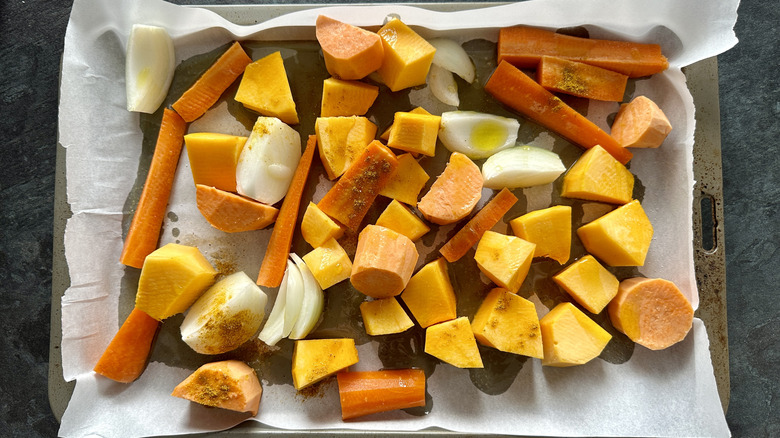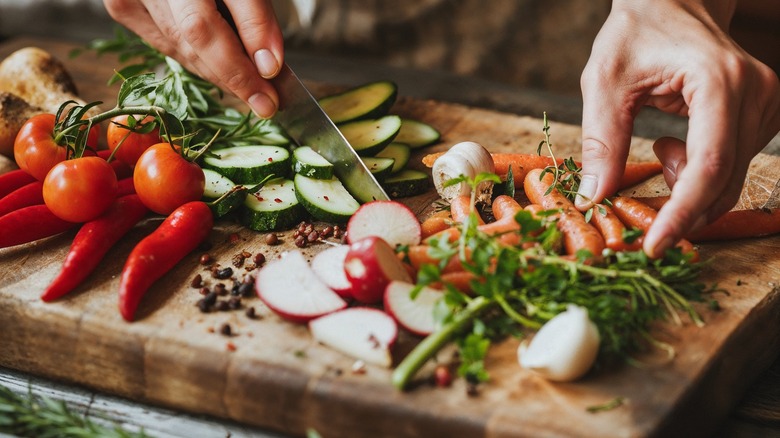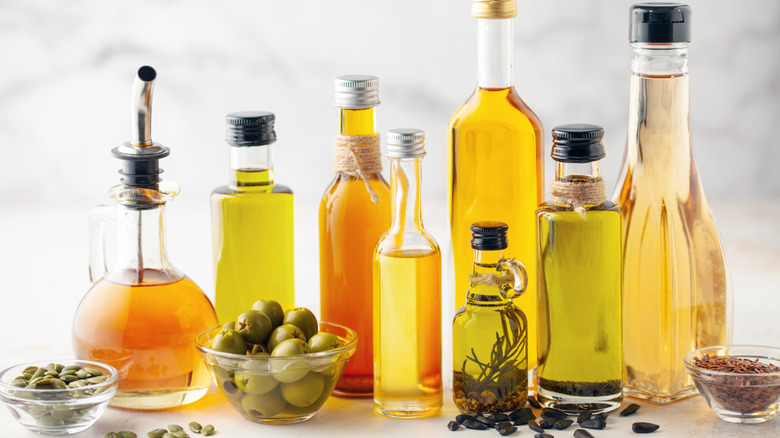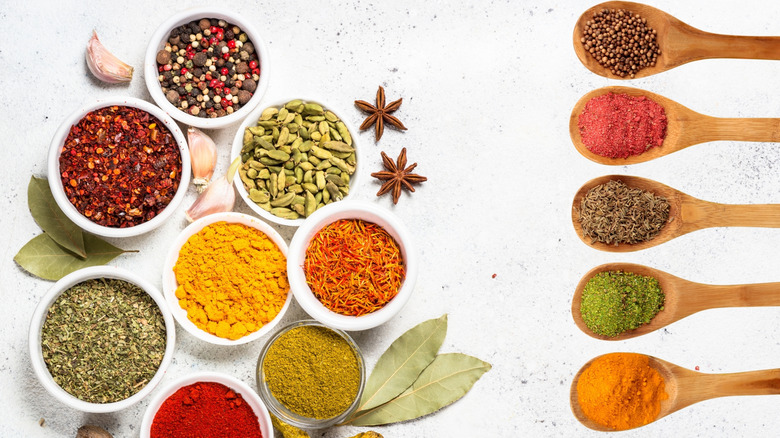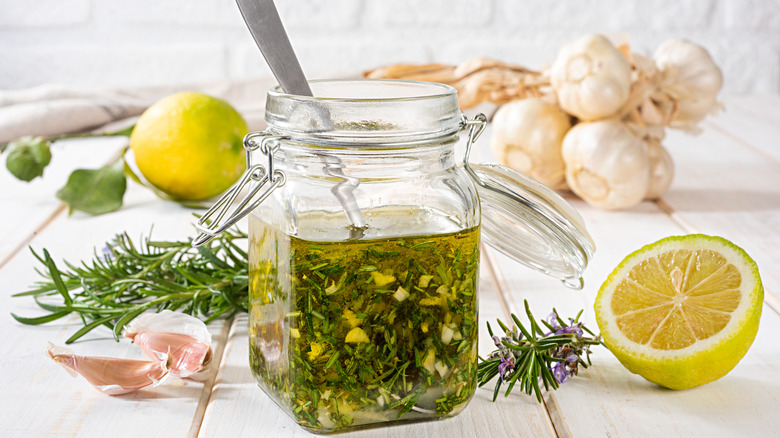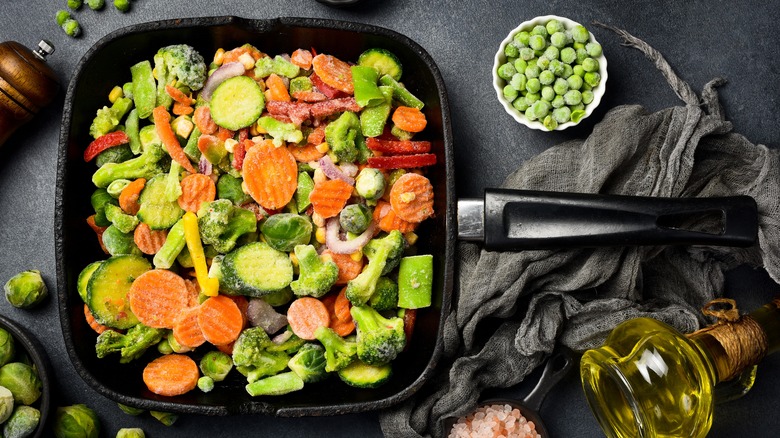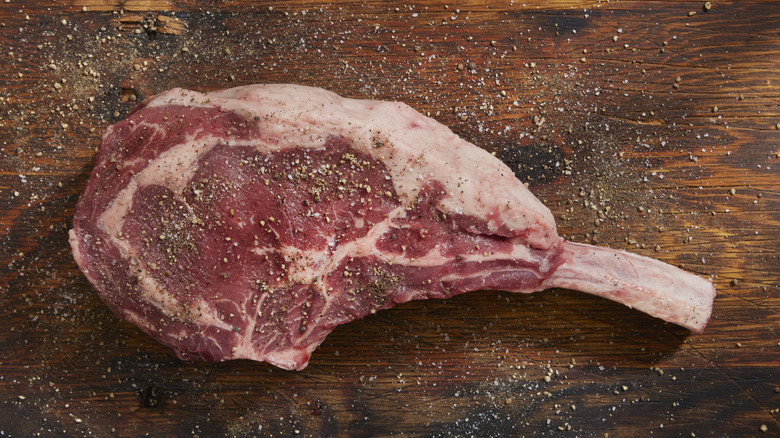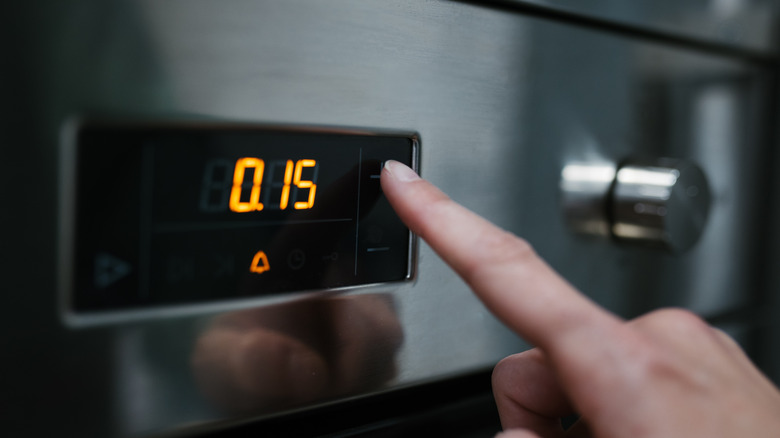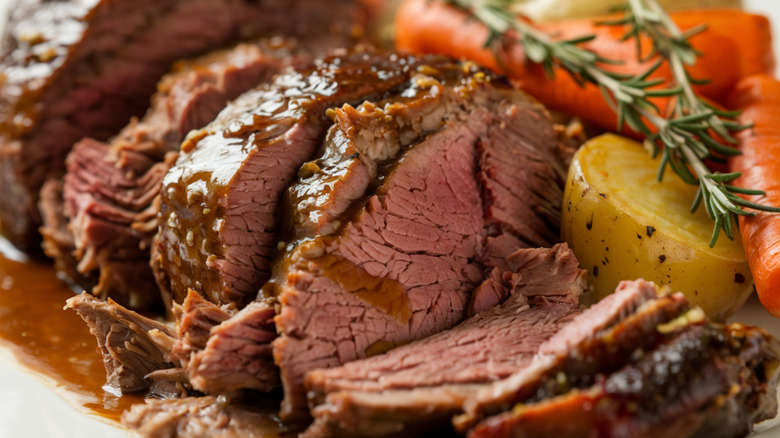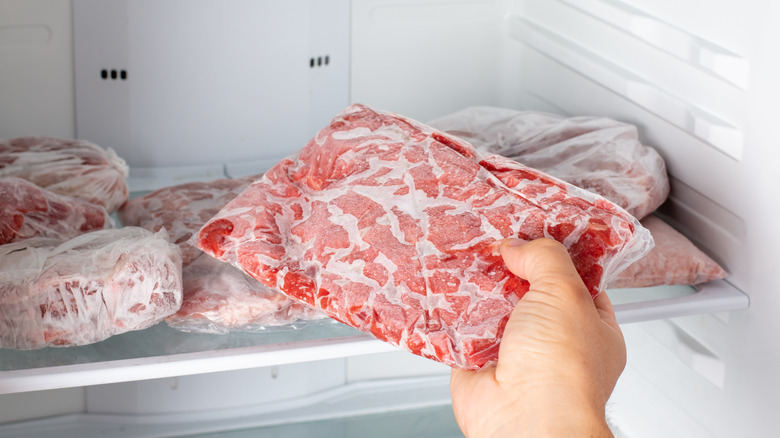13 Big Mistakes You Need To Stop Making With Your Oven Roaster
Oven roasters, known sometimes as electric roasters, are a remarkable bit of 20th century technology. They were invented in 1931 by — surprisingly — NESCO, or the National Enameling and Stamping Company. It became a highly sought-after device that could substitute for wood-burning stoves. A versatile invention with great utility, the oven roaster remains a perfect way to prepare meat and vegetables by roasting, baking, braising, steaming, or slow-cooking. They're popular for their great capacity (they can usually hold 10-20 quarts), which allows you to roast big dinner items like whole turkeys. You can use oven roasters alongside your main oven if you're cooking a ton of stuff for Thanksgiving or other large gatherings.
They're also designed to heat food evenly, distributing heat around the inside walls of the unit while the food cooks. But though this long-standing kitchen marvel makes roasting many times easier than it was in days of yore, it still takes a bit of study and practice to use them to maximum effect. In fact, there are quite a few errors that new roaster users can make if they're not careful. Here are 13 mistakes to avoid as you move toward becoming an oven roaster aficionado.
Going for a cheap roaster instead of a high-quality one
Sometimes, an appliance on a budget just won't cut it. If you want to get serious about oven roasting, your best bet is to do a little research and find some balance between budget and quality. Ideally, your oven roaster should be versatile, allowing you to roast, bake, or slow cook. It should provide reliable heat distribution and reach a max temperature of at least 450 F. The best oven roasters tend to be energy efficient, meaning they ought to retain heat properly and save energy. Any oven roaster worth its salt will also feature a removable pan for easy cleaning.
So what do you want to avoid in an oven roaster? Well, one Quora user bought a cheaper oven roaster unit on a budget and had this to say: "... it doesn't have the greatest temperature control. It's just a dial and a pre-heat light, no screen for it to actually tell you what you have it set to, so you've really gotta keep an eye on it with a good thermometer." They also mention a "flimsy" lid with no insulation to prevent it from becoming dangerously hot — yikes. With oven roasters, you get what you pay for, so do your research and pick something with lots of positive reviews.
Not cleaning the inside of the roaster before using it for the first time
Excited to test out your new oven roaster on that big turkey dinner? Well, not so fast. A lot of brand-new oven roasters are not ready for use the moment they come out of the box. Electric oven roasters are different by brand and model, so it's always a good idea to read the instructions carefully before using it.
However, be aware that some units will have a removable insert with a factory finish substance along its interior. Before direct contact with food, the insert has to be scrubbed clean to avoid contamination. And if you're using a plastic liner or wrap, cleaning the insert will prevent it from sticking to the wrap, which can turn into quite a mess. Some roasters also need to be "cured" before their first use. This means you have to heat the roaster while empty for whatever amount of time the instructions indicate. If you're not sure which of these steps to perform or how to undertake them, the instructions will typically include everything you need to know.
Not using a roaster liner or wrap
Is there anything worse than endlessly scrubbing the inside of a pan to remove stubborn old food residue? You can run your pan through the dishwasher multiple times, and it still won't do the trick. It typically has to be scrubbed by hand, and pretty aggressively. Fortunately, the disposable roaster liner has been invented to save time and energy. Before cooking anything, you wrap the liner around the inside of the roaster insert per your unit's instructions, and the food will never actually touch the insert unit — meaning it never has to be scrubbed.
Depending on the roaster model and type of liner you're using, there may be special instructions regarding heat settings and safety. Some plastic liners can melt at higher temperatures, which is why one trick is to pour a bit of water in the bottom of the insert before wrapping the plastic liner. This creates steam as the roaster heats up, and it prevents the liner from melting into the side of the insert.
Setting the wrong temperature for your veggies
A lot of oven roaster initiates make this mistake. Coming from years of roasting and cooking with a regular oven, they assume they basically already know what they're doing. Among other errors, this commonly leads to would-be chefs turning the oven roaster dial to the wrong temperature. If you do it properly, roasting those veggies will cause them to caramelize, which is a major flavor enhancer.
It may seem better to roast your veggies using the "low and slow" technique, but you typically end up with soggy vegetables that way. This can be perfect if you're going to make a soup, which might require that you puree them. But otherwise, the trick is to roast vegetables at a higher temperature — anywhere from 400 F to 425 F is a good bet. That way, veggies come out properly roasted, crispy, and tasty. If you find that your vegetables always end up burning at those higher temperatures, use an oven thermometer to make sure your roaster is actually heating the food at the temperature it's supposed to.
Unevenly chopping your veggies
You don't have to be a master of the blade to cut your veggies for roasting. That being said, you can't be too hasty about it either. If you don't pay attention while cutting veggies, you can end up with chunks of different sizes. The problem with this outcome is that it can lead to vegetable chunks that don't cook evenly. The bigger chunks will cook slower, and the smaller ones will cook faster. Then you either end up with small, undercooked vegetable pieces or large overcooked ones.
Take your time when cutting and get the pieces roughly even. Then no matter what temperature you cook vegetables at, they'll all have been evenly roasted. Your veggies will have a uniform flavor and consistency that, of course, lends to a more enjoyable meal. It also tends to look better when you serve up the whole ensemble. If you find cutting vegetables properly takes up too much time, just remember that practice makes perfect — the more often you chop veggies, the faster you'll get at it.
Drizzling the wrong amount of oil
Oil is a tricky business. Getting good at this part of the roasting process may take a little time and practice, but once you have a feel for it, you'll hardly notice you're doing it anymore. Oil is important for both meat and vegetables, but especially so for veggies. That's because the oil impacts the consistency of the vegetables, meaning that if you apply too much, the vegetables can become soggy and thick. Then again, if you don't apply enough, you end up with dry vegetables that tend to burn easier.
So how much oil should you apply? The best method is to place the vegetables in a bowl and add 1 teaspoon of oil. Give them a good toss, then check to see if they are evenly coated. If not, you can add an extra tablespoon of oil, toss again, and they ought to be good to go. When you're ready to put the vegetables into the roaster, do it by hand instead of pouring them in — that way, any excess oil at the bottom of the bowl doesn't sneak its way in.
Forgetting spices and herbs
There's nothing wrong with good old fashioned salt, but the world of seasoning has so much more to offer. In fact, some spices actually boast nutritious properties. Turmeric, for example, is an anti-inflammatory. And some varieties of pepper are known to aid in weight management and boost metabolism. Of course, most people are interested in spices because of how dang delicious they are. A proper spicing can completely change up the flavor of the meal.
Garlic powder contributes a pungent bite, rosemary brings a "foresty," herbal flavor, thyme has a slightly minty flavor, and paprika can add sweetness or smokiness to the dish. There are plenty more spices worth trying, including cumin, Italian seasoning, curry powder, za'atar, and plenty of others. Even bacon can be a kind of seasoning. If you roast veggies with bacon, the fat from the meat helps vegetables brown while adding bacon's characteristic smoky and salty flavor. If you'd like to expand your repertoire, use flavored oils, citrus, and even mustard to bring exciting new flavors to dinner.
Not using vinaigrettes to season vegetables
When roasting vegetables, you want to create a balanced flavor for the palate — nobody likes a boring vegetable. To keep things fresh, you want your vegetables to possess that certain "zing." For that, there's nothing like a high-quality vinaigrette. The best way to do this is to toss your raw veggies with a little vinaigrette in a bowl. The maximum you want to use here is a ¼ cup per pound of vegetables. Let those soak for about 10 minutes, and then scoop them into the oven roaster.
So what kind of vinaigrette should you toss your vegetables with? It depends on what veggies you're roasting. There's balsamic, white wine, apple cider, lemon celery seed, and a ton of other tasty dressings that will make those vegetables pop. And while store-bought vinaigrettes are easy to come by (and taste just fine), you can also experiment at home to create your own vinaigrettes. A home brew dressing means you'll have more control over the ingredients, and you can avoid any processed stuff that you might find in prepackaged dressings from the store.
Loading too many veggies in the pan
Vegetable lovers may be tempted to load their oven roaster with as many delicious veggies as possible. It's easy to cruise through the produce section at your local grocery store and pick every vegetable you've ever enjoyed eating. The voice in your head may ask: Why not toss 'em all in? Don't listen to that voice — not if you want delicious caramelized vegetables. If you overpack your oven roaster with veggies, they end up steaming instead. This may be great for broccoli, but not all vegetables steam quite so well. Many can end up limp and lacking in flavor.
The right way to load up your oven roaster with vegetables is to lay them in just one layer with about a ¼ inch between them. This will allow the heat to circulate properly. And if your vegetable types take different amounts of time to cook, think about placing them in stages. First you place the veggies that take longest to cook, leaving space enough for the next stage of vegetables. Once it's time to add the second phase of veggies, you just fill those gaps in the roaster insert.
Not salting the meat the night before roasting it
Meat has got to be seasoned, right? At least, if you want it to be maximally tasty. A lot of inexperienced roasters will simply season the meat and chuck it into the oven unit. There's something of a debate on this subject, depending on which meat you're talking about. Some say that steak, for example, should be salted the night before roasting. Others suggest it should be salted right before.
When you salt your meat the night prior to roasting it, it's true that the meat may seem to dry out a bit. But the amount of moisture lost in this process is basically negligible – because the meat reabsorbs the moisture. None of this means that meat salted right before roasting will taste bad — it can still be delicious. But if you want to optimize the flavor of meat cooking in an oven roaster ... the night before seems to be the way to go.
Not checking in on food while it cooks
It's easy to fill up your roaster, set a time, and go about your day while the food cooks, trusting the oven roaster to get the job done. While the roaster is a pretty impressive machine, technology is not yet so advanced that we can remove the element of human supervision from the roasting process. Sometimes you can follow a recipe to the letter, but some unknown variable is off, and then the whole meal is overcooked.
It doesn't hurt to check in on whatever you're roasting and make sure that all is well. Even if you can read the temperature and timer on your roaster's display, there's nothing quite as effective as using your own senses and give a look-see on the food a few times before it's done. One other thing you can do is pop a thermometer in there while being careful not to touch the reader portion to the sides of the oven roaster. That way you can get a correct read on the food temperature rather than the unit.
Slicing the roast right away after cooking
That oven-roasted meat is smelling mighty fine, and you're ready to dig in. So why not slice your roast right after it's done cooking? Well, when it comes to roasting meat, it's all about the juices. Some roast lovers tested this and found distinct differences between the meat roasts that were sliced right after cooking and those that were allowed to wait. Basically, they cut a finished roast into sections and let the portions wait different amounts of time before checking to see how much juice was retained. The result was that the longer they waited to slice that section of roast, the juicier it was.
This is because when meat is cooked, it causes muscle fibers to contract, and that juice is flexed right out of there and into the space between muscle fibers. If the meat is hot, the juice is thin — when the meat is a little cooler, the dissolved gelatin within the juice becomes firmer, and that in turn makes the juice thicker. This way, more of the juice remains in the muscle. The whole thing amounts to tender, succulent meat. Of course, this goes for most methods of cooking meat, but it's important to mention here, because oven roasters are no exception to this rule.
Not letting your meat come to room temperature before roasting
So you've got a bunch of meat in the fridge or freezer, and you're ready to get roasting. Just pop that chilly meat into the roaster, right? Nope. You actually want to let that meat rest for about an hour before you stick it in the roaster (something Anthony Bourdain says is a crucial step). For one thing, if you place fridge-temperature meat in the roaster, the stark temperature difference between the fridge and the roaster will cause the meat to dehydrate and become less juicy. Additionally, the center of the meat is more likely to come out cold. This is a tricky problem to manage because the outer portions of the meat will cook to perfection, but with the center still chilled — you can either enjoy a cold center or keep cooking the meat, causing the fringes of it to overcook a bit.
There are a few other reasons to let your meat come to room temperature before cooking. If you don't, your meat may lose nutrients. And because meat is so absorbent, it can sometimes even absorb weird odors from the fridge. Letting it warm up outside the fridge gives any unusual smells time to dissipate.

